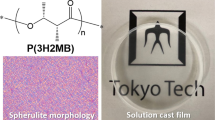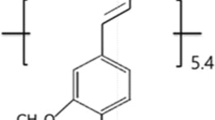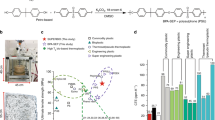Abstract
Aliphatic polyesters, such as poly(lactic acid), which degrade by hydrolysis, from naturally occurring molecules form the main components of biodegradable plastics1. However, these polyesters have become substitutes for only a small percentage of the currently used plastic materials because of their poor thermal and mechanical properties. Polymers that degrade into natural molecules and have a performance closer to that of engineering plastics would be highly desirable. Although the use of a high-strength filler such as a bacterial cellulose2 or modified lignin3 greatly increases the plastic properties, it is the matrix polymer that determines the intrinsic properties of the composite. The introduction of an aromatic component into the thermoplastic polymer backbone is an efficient method to intrinsically improve the material performance3,4. Here, we report the preparation of environmentally degradable, liquid crystalline, wholly aromatic polyesters. The polyesters were derived from polymerizable plant-derived chemicals—in other words, ‘phytomonomers’ that are widely present as lignin biosynthetic precursors5. The mechanical performance of these materials surpasses that of current biodegradable plastics, with a mechanical strength, σ, of 63 MPa, a Young’s modulus, E, of 16 GPa, and a maximum softening temperature of 169 ∘C. On light irradiation, their mechanical properties improved further and the rate of hydrolysis accelerated.
This is a preview of subscription content, access via your institution
Access options
Subscribe to this journal
Receive 12 print issues and online access
$259.00 per year
only $21.58 per issue
Buy this article
- Purchase on Springer Link
- Instant access to full article PDF
Prices may be subject to local taxes which are calculated during checkout



Similar content being viewed by others
References
Stevens, E. S. Green Plastics: An Introduction to the New Science of Biodegradable Plastics (Princeton Univ. Press, New Jersey, 2002).
Yano, H. et al. Optically transparent composites reinforced with networks of bacterial nanofibers. Adv. Mater. 17, 153–155 (2005).
Thielemans, W. & Wool, R. Lignin esters for use in unsaturated thermosets: Lignin modification and solubility modeling. Biomacromolecules 6, 1895–1905 (2005).
Madhavamoorthi, P. VECTRA liquid crystal polymer fiber. Synth. Fibers 33, 16–28 (2004).
Ricarda, N., Anthony, J. M. & Cathie, M. Engineering plants with increased levels of the antioxidant chlorogenic acid. Nature Biotechnol. 22, 746–754 (2004).
Kyndt, J. A., Meyer, T. E., Cusanovich, M. A. & Van Beeumen, J. J. Characterization of a bacterial tyrosine ammonia lyase, a biosynthetic enzyme for the photoactive yellow protein. FEBS Lett. 512, 240 (2002).
Boerjan, W., Ralph, J. & Baucher, M. Lignin biosynthesis. Annu. Rev. Plant Biol. 54, 519–546 (2003).
Cain, R. B., Bilton, R. F. & Darrah, J. A. The metabolism of aromatic acids by micro-organisms. Methanolic pathways in the fungi. Biochem. J. 108, 797–828 (1968).
Kaneko, T., Matsusaki, M., Hang, T. T. & Akashi, M. Thermotropic liquid crystalline polymer derived from natural cinnamoyl biomonomers. Macromol. Rapid Commun. 25, 673–677 (2004).
Tanaka, Y. et al. Solid-state polycondensation of p-hydroxy-trans-cinnamic acid under high pressure. Polym. Lett. Ed. 13, 235–242 (1975).
Flory, P. J. Molecular size distribution in three dimensional polymers. VI. Branched polymers containing A-R-Bf−1 type uints. J. Am. Chem. Soc. 74, 2718–2723 (1952).
Kricheldorf, H. R. & Stoeber, O. New polymer syntheses, 76. Hyperbranched polyesters by polycondensation of silylated 5-acetoxyisophthalic acid. Macromol. Rapid Commun. 15, 87–93 (1994).
Gross, R. A. & Kalra, B. Biodegradable polymers for the environment. Science 297, 803–807 (2002).
Pochan, J. M. & Pochan, D. F. Dielectric relaxation studies of bis[4-(diethylamino)-2-methylphenyl] phenylmethane/polycarbonate solid solutions. A correlation of sub-T, relaxations and the glass transition activation energy. Macromolecules 13, 1577–1582 (1980).
Weng, W., Markel, E. J. & Dekmezian, A. H. Synthesis of long-chain branched propylene polymers via macromonomer incorporation. Macromol. Rapid Commun. 22, 1488–1492 (2001).
Maekawa, Y. et al. Radiation-induced reactions via the lowest excited states in cinnamic acid crystals. Chem. Commun. 2088–2089 (2002).
Lendlein, A., Jiang, H., Juenger, O. & Langer, R. Light-induced shape-memory polymers. Nature 434, 879–882 (2005).
Acknowledgements
This research was supported mainly by a Grant-in-Aid for NEDO (03A44014c) and Handai FRC. T.K. thanks K. Hirata, Y. Nagase, T. Bamba and M. Kaneko (Osaka University) for helpful discussions about bioproduction of phytomonomers and in-soil degradation, Wako Chemical Co. for help with high-performance liquid chromatography measurements and K. Hasegawa and J. Kadota (Osaka Municipal Technical Research Institute) for their help in material processing.
Author information
Authors and Affiliations
Contributions
T.K.: project planning; experimental work; data analysis; paper preparation. T.T.: experimental work; data analysis. D.S.: experimental work; data analysis. M.A.: project planning.
Corresponding authors
Ethics declarations
Competing interests
The authors declare no competing financial interests.
Supplementary information
Supplementary Information
Supplementary figures S1-S8 and table S1 (PDF 661 kb)
Rights and permissions
About this article
Cite this article
Kaneko, T., Thi, T., Shi, D. et al. Environmentally degradable, high-performance thermoplastics from phenolic phytomonomers. Nature Mater 5, 966–970 (2006). https://doi.org/10.1038/nmat1778
Received:
Accepted:
Published:
Issue Date:
DOI: https://doi.org/10.1038/nmat1778
This article is cited by
-
Microbial synthesis of the plant natural product precursor p-coumaric acid with Corynebacterium glutamicum
Microbial Cell Factories (2023)
-
Synthesis of biobased functional materials using photoactive cinnamate derivatives
Polymer Journal (2023)
-
Synthesis of photoresponsive biobased adhesive polymers via the Passerini three-component reaction
Polymer Journal (2023)
-
Global transcriptomic response of Escherichia coli to p-coumaric acid
Microbial Cell Factories (2022)
-
Enhanced production of γ-amino acid 3-amino-4-hydroxybenzoic acid by recombinant Corynebacterium glutamicum under oxygen limitation
Microbial Cell Factories (2021)



